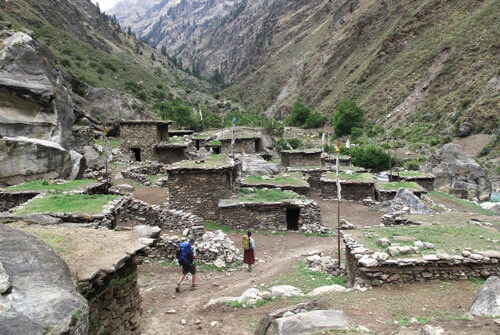January - A Winter Wonderland:
Blanketed by snow and clear blue skies, the beginning month of the year, January welcomes only the most resilient adventurer. Temperatures drop below freezing point and the icy winds chill factor envelope the Khumbu Valley. Despite the extreme cold, the winter wonderland creates magical scenery.
The clear blue sky and the view of peaks and hills adorned in snow create a lovely ambiance. Be prepared with your warmest down jackets and beanies to combat the chill factor outside. Scaling Kala Patthar in January to witness the first rays of the sun kiss the summit of Everest is an iconic highlight.
- Navigating the Challenges in January
However, one must take caution as trails and tea houses remain deserted. Carrying sufficient gear and allowing proper acclimatization time is vital. Be prepared for the coldest of the month in Everest.
- Minimum Temperature: -20°C to -15°C
- Maximum Temperature: -5°C to -2°C
- Average Wind Speed: 15 km/h
February - Tranquil Trails and Cool Air:
As the bitter cold slightly subsides in February, the charm of the quiet off-season will still prevail. Trails will still be quite devoid of crowds, offering seclusion amidst wild nature. Days begin smoothly enduring the morning chills which finally give way to pleasant afternoons in the sun.
- Solitude Amidst Nature in February
For those seeking solitude, now is the time to inhabit the tranquil terrain without maddening crowds of hikers. One can quietly enjoy Everest’s majesty covered across the horizon.
- Minimum Temperature: -15°C to -10°C
- Maximum Temperature: 0°C to 5°C
- Average Wind Speed: 20 km/h
March - Spring Awakening:
Spring starts breathing life back into the mountain landscapes starting March. In March, temperatures climb above freezing and days start becoming warmer. Soon the ample alpine floras and the rhododendrons budding start adorning cliffs and valleys.
The famed Namche Bazaar hums as locals and trekkers flock to the weekly market. Guest houses will be lively with travelers swapping tales over steaming mugs of tea and pots of Rakshi (local wine).
- Witness the budding of alpine flowers in March
Hikers heading up to Base Camp spot wild musk deer and Himalayan Tahr grazing mountain grasses. Nature’s display reaches its peak with a variety of flora budding and blooming on the slopes of Everest meadow.
- Minimum Temperature: -10°C to -5°C
- Maximum Temperature: 5°C to 10°C
- Average Wind Speed: 25 km/h

April - Peak of Spring:
April welcomes perfect trekking conditions with clear weather, vibrant colors, and moderate temperatures. Lush forests burst with flora, painting trails pink and purple with billions of rhododendron blooms. Clear blue skies provide unhindered views of Everest, Ama Dablam, and Lhotse while the Khumbu Icefall sparkles in the distance.
The damp chill of lower elevations gives way to pleasant afternoons at higher camps. As one of the most popular trekking months, the routes buzz with overcrowded hikers, climbers, and locals.
- Perfect Weather Conditions in April
April marks the peak season when the local expedition crews start setting up base camp in preparation for the Everest Expedition. With the arrival of local crews and Sherpa guides, the EBC trail becomes overcrowded with hundreds of yaks carrying supplies.
The expeditions establish their camps as spaces are cleared among the icy terrain, crevasses, and rocks. It is a hectic yet exciting time as the upcoming summiteers make their final preparations for what will be the adventure and challenge of a lifetime.
- Minimum Temperature: -5°C to 0°C
- Maximum Temperature: 10°C to 15°C
- Average Wind Speed: 20 km/h
May – Window for Everest Expedition:
Temperatures continue to climb in May as pre-monsoon conditions set in. Though warm and dry early on, haze gradually reduces the visibility of the snowy giants. The month of May offers the most favorable weather window for reaching the peak of Mount Everest.
It was on May 29th, 1953 that Sir Edmund Hillary and Sherpa Tenzing Norgay made history as the first climbers confirmed to have successfully summited the 29,032-foot mountain. Following in their footsteps, modern-day Everest climbers closely watch the weather forecasts and aim to set off for their summit bids in May.
- Beating the Monsoon Rush in May:
Locals hurry to repair trails and infrastructure before the rains arrive. For those wishing to avoid pouring rain and clouds that obscure epic views, May offers a final chance to glimpse Everest region splendor. As the window narrows, fewer make the pilgrimage to pay homage to the goddess Chomolungma.
- Minimum Temperature: 0°C to 5°C
- Maximum Temperature: 15°C to 20°C
- Average Wind Speed: 15 km/h
June to September - Monsoon Interlude:
From June through September, the monsoon drenches the Himalayan terrain. Though lush and transformed, incessant rain makes trails slippery and dangerous. Most importantly the chances of flying in and out of Lukla airport will be pretty meek. Flooding and landslides often block passages while low clouds swirl around peaks.
As the monsoon clouds fill the landscape, the region becomes shrouded in fog. There is very little chance of having clear weather to enjoy the beauty of the Everest region with its magnificence.
- A Big Break from June till September:
The monsoon season brings an eerie moment in the Everest region each summer. As rain storms sweep up from the Indian plains, the mountain landscapes become shrouded in rain and fog by mid-June. The busy lodges and tea houses close down due to zero travelers. Flights in and out of the small mountain airstrips of Lukla also get canceled frequently due to poor visibility.
Trails become muddy and less inviting. Though lush and transformed, incessant rain makes trails slippery and dangerous. So this section of the year makes the biggest break of the year in the Everest region.
October - The Revival- The Peak Autumn Season:
October brings refreshing weather after the summer monsoon rains stop. Now the skies are clear to showcase breathtaking views of snowy mountain peaks. With pleasant days and moderate nights, conditions become perfect for trekking again. More visitors come to hike the trails and see the stunning landscapes at this best time of year. Porters march up carrying supplies to lodges.
The entire Everest trail lightens up again with the rush of trekkers, locals opening up their shops, and teahouses being occupied by trekkers. Once again, the atmosphere of Everest will be vigorous with so many activities including the scent of incense and the Tibetan mantra chants all the way.
- Festive Trekking Atmosphere in October:
Out of all the months, October draws in the biggest crowds as people flock to admire the majestic Himalayan scenery. It will be more like an annual festival where everyone is all set to celebrate it. The clean mountain air, the bright sun shining on high passes, and the jewel-like hillsides make October a spectacular spell in the Everest region.
- Minimum Temperature: -5°C to 0°C
- Maximum Temperature: 10°C to 15°C
- Average Wind Speed: 15 km/h
November - Autumn Splendor:
As autumn descends, November welcomes cooler weather and dazzling colors. The morning frost makes the tall mountain peaks glitter when the sun rises. The air smells fresh from juniper and rhododendron flowers still blooming at the end of season. Views are very clear, and there are less crowds.
Photographers like November light that shines warm on the mountains at sunrise and sunset. It's a quieter time to enjoy the Himalayan beauty before winter comes with more snow and chill. The fall colors over the landscape make November a special month here after the busier trekking seasons end.
- Capturing Autumn's Glory in November
In November, the Himalayan foothills glow with vibrant colors presenting a perfect time for photographers with stunning vantages. This autumn month paints Everest landscapes contrasted against the mighty snow summits.
- Minimum Temperature: -10°C to -5°C
- Maximum Temperature: 5°C to 10°C
- Average Wind Speed: 20 km/h
December - Year-End Adventure:
Though climate change has impacted the Himalayas with warmer average temperatures and unpredictable weather patterns, December in the Everest region can remain the BEST month for trekking. As winter sets in, the mountain landscapes take on a mystical beauty shrouded in snow in December.
Long-distance views open up with heightened clarity in the drier air. As long as trekkers come properly equipped for colder temperatures, December trekking can offer unmatched scenery combining snow-dressed summits and valleys with relatively accessible and walkable routes.
Now the BEST time to Trek in Everest is December:
December now is considered the best time to trek to Everest Base Camp.
WHY – Click Here for Further Details
- Minimum Temperature: -15°C to -10°C
- Maximum Temperature: 0°C to 5°C
- Average Wind Speed: 20 km/h
Conclusion:
The Everest Base Camp trek offers adventures all year round. Each month has something different - from snowy, quiet winters to busy trekking seasons with festivals. Whether you want to be alone on the trail or join big groups, there is an amazing experience waiting for any month.
As you walk through impressive Himalayan scenery and look up at the tall Everest peak, you'll create lifelong memories. The trip has iconic views and excitement no matter when you go. Just get your boots and gear and be ready to explore!






